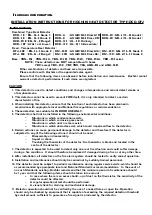
i1 HOCHIKI CORPORATION
INSTALLATION INSTRUCTIONS FOR HOCHIKI HEAT DETECTOR TYPE:DCD, DFJ
INTRODUCTION
Combined Type Heat Detector :
DCD-1 E (EN-54-5 Grade 1)
DCD-2E (EN-54-5 Grade 2)
DCD-R1E (EN-54-8 Range1)
DCD-1EF (NF S61-950 Grade 1)
DCD-A
DCD-C
DCD-135
DCD-190
Fixed- Temperature Heat Detector :
DFJ-60E (EN-54-5 Grade 2)
I
DFJ-608
DFJ-90E (EN-54-8 Range1) DFJ-90D
(AS ISO7240.5 Class A1R)
(AS ISO7240.5 Class CR )
(UL-521 Ordinary)
(UL-521 Intermediate)
(AS ISO7240.5 ClassA1S )
(AS ISO7240.5 Class CS)
DCD-2C (GB-4716-93 Grade 2)
DCD-3C (GB-4716-93 Grade 3)
I
DFJ-60C (GB-4716-93 Grade 2)
DFJ-70C (GB-4716-93 Grade 3)
Base : YBN-R/4, YBN-R/4A, YBN-R/48, YBN-R/4C, YBO-R/4A, YBO-R/5 series
NOTE : These detectors are NOT compatible with bases
YBC(except YBC-R/3), YBF, YBK, YCA, AMU-B2 and AMU-MB
Other combinations of detector and base are also possible.
Please confirm with Hochiki or the appointed sales agent.
Ensure that the following items are observed before installation and maintenance. Hochiki cannot
warrant a detector's performance if such items are neglected.
CAUTION
1. This detector is used to detect conditions and changes in temperature and cannot detect smoke or
other phenomena.
2. This detector cannot be used to prevent FIRE itself, it is only intended to detect a certain
characteristic of fire.
3. When installing this detector, ensure that the location of each detector has been planned in
accordance with appropriate local and National fire regulations or recommendations.
4. These detectors are suitable for IN DOOR USE ONLY.
5. The detector shall not be installed in the following environmental conditions:
Situations in which condensation exists.
Situations in which corrosive gases exist.
Situations in which dust or steam exist.
Situations in which obstacles exist, which could impede airflow to the detector.
6. Certain actions can cause permanent damage to the detector and therefore if the detector is
subjected to any of the following actions it should not be used :
Disassembly and reassembly.
Impact or shock.
Touching the thermistor of the detector (the thermistor is black and located in the
centre of the detector ) .
7. The detector is expected to be used to detect only one real fire situation and could suffer damage
during a fire condition. It should therefore be replaced if damaged during a fire or at any other time.
8. After installation, all detectors on the fire alarm system should be tested to verify correct operation.
9. Installation and maintenance should only be carried out by suitably trained personnel.
10. The detector must be subject to periodic maintenance during regular service visits, which should be
as recommended by appropriate local and National Standards or recommendations. In the event of
no such Standards existing, Hochiki recommend that the minimum period of maintenance should
be 1 year and that the following items should be taken into account :
In case where there is an excess build-up of dust on the thermistor, the sensitivity of the
detector could be affected.
A regular operational test should be performed.
A visual check for staining and mechanical damage.
11. Detector operation should not be verified by the use of a naked flame or open fire. Operation
should only be checked by equipment that is capable of exceeding the required detection threshold
by small amount, sufficient to guarantee a fire signal is produced by the detector.


